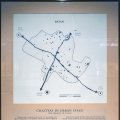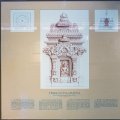Patan Museum (Nepal): photo 120
Photo 120 of 212 in Gallery: Patan Museum (Nepal)

Image title: Chaityas of the Kathmandu valley
Description of the photo
Chaityas of the Kathmandu valley: a comparison [drawing by Bijay Basukula, 1995]—
1. Southern Stupa in Patan, 3rd-4th century (?);
2. The Great Chaitya of Bodhnath, established 5th century, reshaped 1500;
3. The Great Chaitya of Svayambhunath, established 5th century, reshaped 1918;
4. Kathesimbhu Chaitya in Kathmandu, established 15th century (?), renovated 1920;
5. Dharmadeva Chaitya in Chabahil, established 5th century;
6. Vasubandhu Chaityaon Svayambhunath Hill, established 1825;
7. Chaitya at Pinani in Sanagaon village, 17th century.
This scaled comparison of seven prominent chaityas reveals a remarkable variety of proportion and detail. The domes of three chaityas (1, 3, 5) are based on a circular platform which serves as the drum. The domes of the others are placed on a multi-tiered substructure of 20 angles, a ground plan replicating a mandala. The ancient mound in Patan (1) is, in circumference, the largest chaitya in Nepal. In fact, the height equals that of the dome of the Great Chaitya of Bodhnath (2). The Patan mound was only recently circumscribed by a low brick wall and surmounted by a structure that is in itself a chaitya.
The domes of the chaityas of Patan (1), Svayambhu [Swayambhu] (3), and Dharmadeva (5) are the most prominent elements. But the dome of Bodhnath [Bodhanatha] (2) was relegated to a secondary role when the chaitya was thoroughly rebuilt almost 500 years ago, dominated by the mandala-like substructure. The Bodhnath dome is bulgy and uninterrupted by niches, unlike all other domes of the group, on which the Five Buddhas and their respective consorts are represented. Vairochana always appears as the iconographical visualization of the center, while his emanations define the cardinal directions.
The builders of the Vasubandu chaitya (6) aimed at a more monumental scale than was normally practiced in the 19th century, probably because of the Five Buddhas. The Tibetan monks utilized the old stone images of the Five Buddhas of Svayambhu chaitya 150 years after the old images were replaced by metal ones. The finials of these seven chaityas also vary. From the chaitya-mound of Patan (1), a central pillar originally emerged without any superstructure. Later chaityas invariably incorporated a finial of thirteen tiers, either stepped (2, 5, 6), or shaped as wooden discs (3, 4).
On the larger chaityas, such as the One in Sanagaon village (7), these tiers appear as stylized levels moulded in stone. Invariably, a crowning parasol with repeated bell and vase symbols above the central axis has been added. Clearly the chaitya never attained a final shape; its original scheme: was not preserved; Ever new layers of votive elements may be added. Ancient accounts, however, advise against a change in proportion when the chaitya’s central pillar is renewed.
Gallery information:
The Patan Museum is located on the Durbar square of Patan (Lalitpur/Lalitapura, Kathmandu, Nepal) which is associated Keshav Narayan Chowk (Keshavnarayan)—a form of Lord Vishnu. Being listed as a World Heritage Site, the whole of Durbar square is filled with exquisite temples, sculptures and other ancient structures, of which the ancient history history can be traced to the Malla Kings of Lalitpur. It is an important site for both Buddhism and Hinduism.
Photo details:
Date: 2019-12-02
Camera: SONY ILCE-6400
Exposure: 1/160
Aperture: f/3.5
ISO: 1600
Focal length: 18mm
High resolution:
Download file
Size: 2.58 MB
Resolution: 2040 x 2000
© Photograph by Gabe Hiemstra.
License: CC BY-NC-ND 4.0

